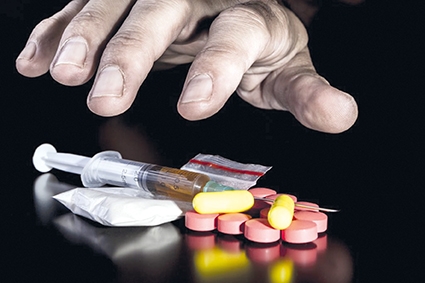European Drug Report 2018 Released
On June 7, the 2018 European Drug Report was released by the European Monitoring Center for Drugs and Drug Addiction. While the report does not cover Georgia, the drug trends in Europe affect Georgia as well. One transportation route for heroin into Europe identified in the report goes through the Southern Caucasus. The following is an abridged version of the report highlights. The full report can be found at www.emcdda.europa.eu/.
The EMCDDA report notes that, across the board, drug availability is high and, in some areas, appears to be increasing. Latest figures show that in Europe (EU-28, Turkey and Norway) over 1 million seizures of illicit drugs were reported in 2016. Over 92 million adults in the EU (15–64 years old) have tried an illicit drug in their lifetime and an estimated 1.3 million people received treatment for illicit drug use in 2016 (EU-28).
Dimitris Avramopoulos, European Commissioner for Migration, Home Affairs and Citizenship, says: “We are seeing higher drug production and availability in Europe today. On top of that, the illicit drug market is highly dynamic and adaptable — and therefore all the more dangerous. If we want to stay ahead of the game, our efforts must focus on building both resilience and responsiveness, not least because of the growing importance of the online market and the development of new types of drugs. With the new rules on new psychoactive substances entering into force by the end of the year, Europe will be equipped with additional, stronger tools to tackle those challenges more effectively and better protect European citizens against dangerous drugs.”
Cocaine is the most commonly used illicit stimulant drug in Europe. Around 2.3 million young adults (15–34 years) have used the drug in the last year (EU-28). Against a backdrop of signs of rising coca cultivation and cocaine production in Latin America, today’s analysis confirms that Europe’s cocaine market is buoyant, with indicators now pointing to increased availability of the drug in a number of countries. Although the price of cocaine remained stable, its purity at street level reached its highest level in a decade in 2016. The number of cocaine seizures has also risen. Some 98,000 seizures of the drug were reported in the EU in 2016 (90,000 in 2015), amounting to 70.9 tons. Between 2015 and 2017, there was an increase in cocaine residues found in wastewater in 26 of the 31 cities with data for that period. The highest traces were recorded in cities in Belgium, the Netherlands, Spain and the UK, with low levels reported in the eastern European cities studied.
The report reveals a rise in the number of first-time admissions to specialized treatment relating to cocaine. In total, over 67,000 clients entered specialized treatment for cocaine-related problems in 2016. Of particular concern are the estimated 8,300 clients who entered treatment for primary crack cocaine use in 2016. Furthermore, cocaine was the second most common drug to be reported in drug-related hospital emergency presentations in a network of 19 sentinel hospitals in 2016 (Euro-DEN Plus).
Trafficking methods and routes also appear to be changing. The Iberian Peninsula — historically the main entry point for maritime shipments of cocaine into Europe — though still important, appears less prominent in the 2016 data, with large seizures now reported in container ports further north. In 2016, Belgium seized 30 tons of cocaine (43% of the annual estimated total amount of cocaine seized in the EU).
Cannabis remains the most widely used illicit drug in Europe. Some 17.2 million young Europeans (15–34 years) have used cannabis in the last year (EU-28) and around 1% of European adults (15–64 years) are daily or almost daily users (EU-28). Recent changes in the regulatory framework for cannabis in parts of the Americas — including legalization in some jurisdictions — have led to the rapid emergence in these locations of a commercial, recreational cannabis market. It is unclear what the implications for Europe will be if a large legal market for this drug develops in parts of the Americas, but an impact on patterns of supply or use in Europe cannot be ruled out.
While overall, in terms of volume, traditional offline drug markets still predominate, online markets appear to be of growing importance, posing a new challenge for drug control measures. A recent EMCDDA–Europol study identified over 100 global darknet markets, on which around two-thirds of purchases were drug-related. The surface web and social media also appear to be growing in importance, especially regarding the supply of NPS and access to misused medicines.
The report highlights concern over the high number of drug overdose deaths in Europe, which has been rising over the last four years. Over 9,000 overdose deaths, mainly related to heroin and other opioids — although often combined with other substances, particularly alcohol and benzodiazepines — are estimated to have occurred in Europe in 2016 (EU-28, Turkey and Norway). The challenges posed by old and new opioids place a renewed focus on the role of the opioid antidote naloxone in overdose response strategies. The report underlines the urgent need to “review current naloxone policies and increase training and awareness-raising for both drug users and professionals who may encounter these drugs.”
Chair of the EMCDDA Management Board Laura d’Arrigo concludes: “The threats posed by drugs to public health and security in Europe continue to require a united response. The EU action plan on drugs, adopted in 2017, provides the framework for European cooperation. As drug problems shift and new trends appear, it is crucial that our monitoring system keeps pace. The European Drug Report, along with 30 country reports, provide the latest analysis to help decision-makers gain a clear picture of the phenomenon and adapt the political response to prevent and face emerging challenges.”
Source: EMCDDA
By Samantha Guthrie












